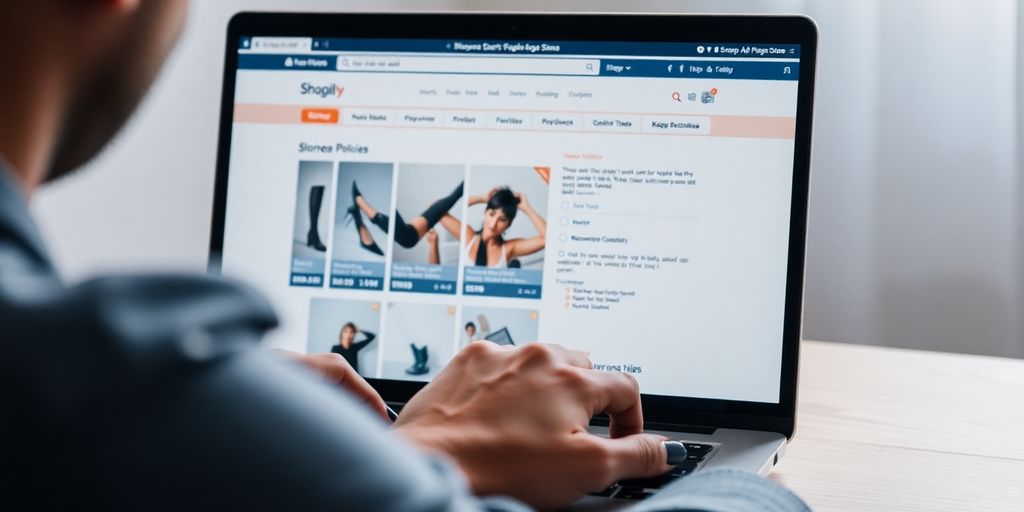Shopping online can be a breeze, but it also comes with risks. With so many fake stores popping up, it’s crucial to know how to tell the difference between real or fake stores before you hand over your hard-earned cash. This guide will help you spot the warning signs, check for safety features, and ensure you’re shopping from trustworthy sites. Let’s dive into some practical tips to keep your online shopping experience safe and secure.
Key Takeaways
- Always look for signs of legitimacy, like proper contact info and clear policies.
- Check for HTTPS in the URL to ensure a secure connection.
- Research the store’s reputation through reviews and social media.
- Use secure payment methods to protect your financial information.
- Trust your instincts; if something feels off, it probably is.
Recognizing Red Flags of Fake Stores
It’s getting harder to tell what’s real and what’s not online. Fake stores are getting sneakier, so knowing the warning signs is super important. Here’s what to look out for:
Unbelievably Low Prices
If a deal seems too good to be true, it probably is. I mean, come on, who’s really selling those high-end headphones for 80% off? Scammers use super low prices to lure you in, hoping you’ll jump at the chance without thinking twice. Always compare prices across multiple sites before you get too excited. If one site is way cheaper than everyone else, that’s a red flag.
Pressure Tactics in Sales
Watch out for websites that try to rush you into buying something. Phrases like “Limited stock!” or “Sale ends today!” are designed to make you panic and not think clearly.
- Creating a sense of urgency is a common trick.
- They don’t want you to have time to research the store or the product.
- A real store will usually give you a reasonable amount of time to make a decision.
I once saw a site that had a countdown timer that reset every time I refreshed the page. It was so obviously fake, but I can see how it might trick some people.
Lack of Contact Information
This is a big one. A legitimate store will always have clear and easy-to-find contact information. I’m talking about a real phone number, a physical address, and a working email address. If all you see is a generic contact form, be very careful. Try calling the number or sending an email to see if you get a response. If the address seems fishy (like a P.O. box or a random residential address), that’s another bad sign. No contact info? No trust.
Verifying Website Security Features
It’s easy to get caught up in the excitement of online shopping, but before you enter any personal information, take a moment to check if the website is secure. It’s like checking the locks on your doors – a simple step that can save you a lot of trouble.
Checking for HTTPS
The first thing to look for is “HTTPS” in the website address. This means the site has a Secure Socket Layer (SSL) certificate, which encrypts the data you send to the site. Without it, your information could be intercepted. Most browsers show a padlock icon next to the URL to indicate a secure connection. No padlock? Proceed with caution. It’s a basic, but important, first step.
Identifying Site Seals
Site seals are another visual cue that a website is legitimate. These seals are usually issued by security companies after they’ve verified the website’s identity.
Here’s what to look for:
- Clickable Seals: A real site seal should be clickable, taking you to a page with more information about the website’s security certificate. If it doesn’t click or takes you to a weird page, it’s probably fake.
- Recognizable Brands: Look for seals from well-known security companies. If you’ve never heard of the company, do a quick search to see if they’re legitimate.
- Up-to-Date Information: The seal should show that the website’s security certificate is current and valid. Expired certificates are a red flag.
Think of site seals as a digital handshake. They’re a way for websites to show you they’re trustworthy. But just like in real life, you shouldn’t trust everyone at face value. Always double-check.
Using Website Checkers
If you’re still unsure about a website, use a website checker to get more information. These tools analyze websites for security risks and can help you spot potential scams. There are several free website checkers available, such as:
- Google Safe Browsing
- Norton Safe Web
- VirusTotal
These checkers will tell you if a website has been flagged for malware, phishing, or other security threats. It’s like having a second opinion from a security expert. They provide detailed insights into a site’s security status. All you have to do is drop the URL into the status checker to see if it’s safe or vulnerable to threats like malware, phishing, or weak encryption.
Researching Store Reputation
It’s easy to get caught up in a good deal, but before you enter your credit card info, take a moment to see what others are saying about the store. A little research can save you a lot of headaches.
Reading Customer Reviews
Customer reviews are gold. They give you real-world experiences from people who’ve already taken the plunge. Look beyond the star rating and read the actual comments. Are there recurring themes? Do people praise the product quality but complain about shipping times? Or are there red flags like consistently poor service or products that don’t match the description? Don’t just look at the store’s website; check third-party review sites for a more balanced view. Keep in mind that some reviews might be fake, so look for patterns and consistency.
Checking Social Media Presence
Most legitimate businesses have a social media presence. Check if the store has accounts on platforms like Facebook, Instagram, or X. How active are they? Do they respond to customer inquiries? A lack of social media presence, or a very new and inactive one, can be a warning sign. Also, see what people are saying in the comments. Are customers happy, or are they complaining about orders? Social media can offer a quick snapshot of a store’s reputation and customer service quality. It’s also a good place to see if the store is running any promotions or engaging with its customer base. You can also check for loyalty expressions in online reviews.
Consulting Consumer Protection Sites
Consumer protection sites and agencies are there to help you avoid scams. The Better Business Bureau (BBB) is a good place to start. See if the store is listed and what its rating is. You can also check with your local consumer protection agency to see if any complaints have been filed against the store. These sites often have resources and information to help you spot scams and protect yourself. It’s a good idea to search for the store’s name plus words like “scam” or “complaints” to see if anything negative comes up.
It’s important to remember that even with all the research in the world, there’s still a chance you could encounter a problem. However, by taking the time to check a store’s reputation, you significantly reduce your risk of getting scammed. Trust your gut, and if something feels off, it’s better to err on the side of caution.
Understanding Payment Safety

Using Secure Payment Methods
When shopping online, it’s super important to use payment methods that offer some level of protection. Credit cards are generally a safer bet than debit cards, because they often have fraud protection policies that can help you get your money back if something goes wrong. Payment platforms like PayPal also offer a buffer between you and the seller, adding an extra layer of security. I always try to use my credit card when I’m buying from a new or unfamiliar website. It just gives me a little more peace of mind.
Avoiding Direct Bank Transfers
Direct bank transfers should be avoided when dealing with unfamiliar online stores. These transfers are often irreversible, meaning if you get scammed, it’s unlikely you’ll get your money back. Scammers love this method because it’s hard to trace and recover funds. If a store insists on a direct bank transfer, that’s a major red flag. I’d rather miss out on a deal than risk losing my money that way.
Recognizing Payment App Risks
Payment apps like Zelle are great for sending money to friends and family, but they’re not always the best choice for online purchases, especially from unknown sellers. According to Wells Fargo, Zelle should only be used for sending money to people you trust. Neither Wells Fargo nor Zelle offers purchase protection purchase protection for payments made with Zelle. If you don’t receive the item you paid for, or if it’s not as described, you’re probably out of luck. Always be cautious when using these apps for transactions with strangers. It’s better to stick with methods that offer some kind of buyer protection.
I once got burned using a payment app to buy something from a seller on social media. The item never arrived, and the payment app couldn’t do anything about it. Now, I only use those apps for sending money to people I know personally. It’s a lesson I learned the hard way.
Examining Store Policies

It’s easy to get caught up in the excitement of a potential purchase, but slowing down to check a store’s policies can save you a lot of trouble. Legitimate businesses usually have clear, easy-to-find policies. Shady ones? Not so much.
Return and Refund Policies
Always read the return and refund policy before buying anything. Look for details about how many days you have to return an item, who pays for return shipping, and what condition the item needs to be in. If a store doesn’t have a clear return policy, or if it’s full of confusing jargon, that’s a big red flag. A real store will make this information accessible.
Privacy Policy Transparency
Take a look at the store’s privacy policy. It should explain what information they collect from you, how they use it, and whether they share it with third parties. If the policy is vague, nonexistent, or asks for way too much personal information, be careful. You want to make sure your data is safe.
Shipping Information Clarity
Check the shipping information. Does the store clearly state how long shipping takes, how much it costs, and which carriers they use? If they don’t provide this information upfront, or if the shipping costs seem unusually high, it might be a sign that something isn’t right. I once ordered something from a site that didn’t list shipping costs until after I’d entered all my payment info – lesson learned!
It’s a good idea to screenshot the store’s policies before you buy anything. That way, if they change the policies later, you’ll have proof of what the terms were when you made your purchase.
Trusting Your Instincts
Sometimes, despite all the checks and balances, something just feels off about a store. It’s that nagging feeling you can’t quite put your finger on. Don’t ignore it! It could be your subconscious picking up on subtle cues that you haven’t consciously registered.
Recognizing Suspicious Behavior
Have you ever landed on a site and immediately felt uneasy? Maybe the layout is weird, the images are low-quality, or the language is stilted. These are all potential red flags. Scammers often rush to set up fake sites, so they might not pay attention to the details that legitimate businesses do. Trust your gut if something seems unprofessional or inconsistent. It’s better to be safe than sorry. For example, if a site is pushing artificial intelligence too hard, it might be a scam.
Listening to Your Gut Feelings
Your intuition is a powerful tool. If a deal seems too good to be true, it probably is. If the store is pressuring you to buy something immediately, that’s a bad sign. If you feel rushed or uncomfortable, take a step back. It’s okay to say no, even if you can’t explain exactly why you’re hesitant.
Taking Time Before Purchase
Don’t let the fear of missing out (FOMO) cloud your judgment. Scammers often use limited-time offers to pressure people into making quick decisions. Resist the urge to buy something immediately. Take some time to research the store, read reviews, and compare prices. A legitimate business will understand if you need time to think things over.
It’s easy to get caught up in the excitement of a potential bargain, but taking a pause can save you from a lot of headaches down the road. A few extra minutes of research can make all the difference between a great deal and a costly mistake.
Here are some things to consider:
- Does the site have a clear and easy-to-find return policy?
- Is the contact information readily available and legitimate?
- Do the product descriptions seem accurate and detailed?
Reporting Suspicious Stores
It’s a bummer, but sometimes you stumble upon a store that just feels off. Don’t ignore that feeling! Reporting these potential scams helps protect others and can even lead to the site being shut down. Here’s how to do it.
How to Report a Scam
First, gather as much evidence as you can. This includes screenshots of the website, product pages, ads you saw, and any communication you had with the store. The more information you have, the better. Keep records of transaction details, like dates, amounts, and payment methods used. Then, decide where to report the scam. There are several avenues you can pursue, depending on the nature of the scam and where you live.
Using Online Reporting Tools
Several online tools can help you report suspicious stores. Here are a few options:
- The Better Business Bureau (BBB): You can file a complaint on the BBB website, which can help resolve disputes and alert others to potential scams.
- The Federal Trade Commission (FTC): The FTC’s Complaint Assistant is a great resource for reporting fraud and scams. They use the data to build cases against scammers.
- The Internet Crime Complaint Center (IC3): If you believe you’ve been a victim of internet crime, report it to the IC3, a partnership between the FBI and the National White Collar Crime Center.
Reporting a scam might feel like shouting into the void, but it’s a crucial step. Even if you don’t get your money back, your report can help prevent others from falling victim to the same scam.
Informing Consumer Protection Agencies
In addition to online tools, consider contacting your local consumer protection agencies. These agencies can investigate scams and take legal action against fraudulent businesses. Your state’s Attorney General’s office is another good place to report scams. They often have dedicated consumer protection divisions that handle these types of complaints. Don’t hesitate to reach out – they’re there to help!
Wrapping It Up: Stay Smart While Shopping Online
At the end of the day, being careful online is key. The internet is full of great deals, but it’s also a playground for scammers. By keeping an eye out for the signs we talked about—like checking URLs, looking for site seals, and using website checkers—you can protect yourself from falling for a fake store. Remember, if something feels off, trust your gut. It’s better to miss out on a deal than to risk your money or personal info. So, take your time, do your homework, and shop smart. Happy shopping!
Frequently Asked Questions
What are some signs of a fake online store?
Look for super low prices, pressure to buy quickly, and missing contact info.
How can I check if a website is secure?
Make sure the website uses HTTPS, look for site seals, and use online tools to check its safety.
How do I find out if a store is trustworthy?
Read customer reviews, check their social media, and visit consumer protection websites.
What payment methods are safe to use online?
Use credit cards or trusted payment apps, and avoid direct bank transfers.
What should I look for in a store’s policies?
Check if they have clear return and refund policies, a privacy policy, and clear shipping details.
What should I do if I suspect a store is a scam?
Trust your instincts, take your time before buying, and report the suspicious store online.



